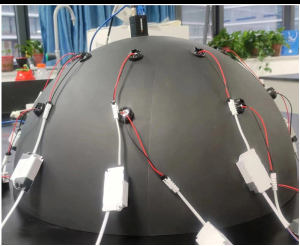
Along with the improvement of quality requirements in industrial production, surface inspection of workpiece has gradually become an indispensable and important process in the production of the workpiece. Aiming at the traditional methods in textured paper inspection, there are problems of low efficiency and large error; based on machine vision, we propose a “photometric stereo vision + fast Fourier enhancement + feature fusion” composite structure inspection method. First, as the traditional CCD camera produces obvious noise and scratches, which are difficult to distinguish from the background texture area, we propose combining the photometric stereo vision measurement algorithm to get the surface gradient information of the textured paper to obtain more gradient texture information; and then realize the secondary enhancement of the image through Fourier transform in spatial and frequency domains. Second, as the textured paper scratches are difficult to detect, the features are difficult to extract, and the threshold boundary is difficult to define, we propose dynamic threshold segmentation through multi-feature fusion to realize the surface scratch detection work of textured paper. We designed experiments using more than 300 different textured papers; and the results show that the composite structure detection method proposed in this paper is feasible and has advantages.
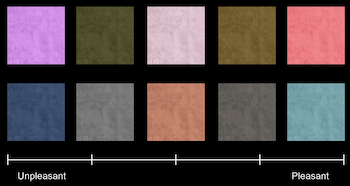
Understanding multimodal interaction and its effects on user experience and behavior is becoming increasingly important with the rapid development of immersive mixed-reality applications. While significant attention has been devoted to enabling haptic feedback in multisensory extended reality systems, research on how the visual and tactile properties of materials and objects interact is still limited. This study investigates how the color appearance of texture images affects observers' judgments of different tactile attributes. For this purpose, we captured images of different texture samples and manipulated the color of the images based on the previously reported consistent mapping of tactile descriptors onto color space. The observers were asked to rate these textures on different haptic properties to test the effects of color on their perception of materials. We found that the effect of changing color is most significant for the perception of heaviness, warmness, and naturalness of textures. For these attributes, a strong correlation between ratings of textures and ratings of uniform color patches of similar colors was also observed, while other attributes, such as hardness, dryness, or pleasantness, showed low or no correlation. The results can increase our understanding of the role of color as a visual cue in estimating material properties of visual textures and for designing and rendering surface properties of objects in 3D printing and virtual and augmented reality applications, including online shopping and gaming.
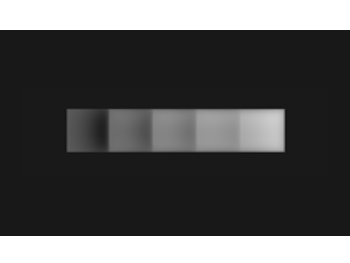
A model of lightness computation by the human visual system is described and simulated. The model accounts to within a few percent error for the large perceptual dynamic range compression observed in lightness matching experiments conducted with Staircase Gelb and related stimuli. The model assumes that neural lightness computation is based on transient activations of ON- and OFF-center neurons in the early visual pathway generated during the course of fixational eye movements. The receptive fields of the ON and OFF cells are modeled as difference-of-gaussian functions operating on a log-transformed image of the stimulus produced by the photoreceptor array. The key neural mechanism that accounts for the observed degree of dynamic range compression is a difference in the neural gains associated with ON and OFF cell responses. The ON cell gain is only about 14 as large as that of the OFF cells. ON and OFF cell responses are sorted in visual cortex by the direction of the eye movements that generated them, then summed across space by large-scale receptive fields to produce separate ON and OFF edge induction maps. Lightness is computed by subtracting the OFF network response at each spatial location from the ON network response and normalizing the spatial lightness representation such that the maximum activation within the lightness network always equals a fixed value that corresponds to the white point. In addition to accounting for the degree of dynamic range compression observed in the Staircase Gelb illusion, the model also accounts for change in the degree of perceptual compression that occurs when the spatial ordering of the papers is altered, and the release from compression that occurs when the papers are surrounded by a white border. Furthermore, the model explains the Chevreul illusion and perceptual fading of stabilized images as a byproduct of the neural lightness computations assumed by the model.
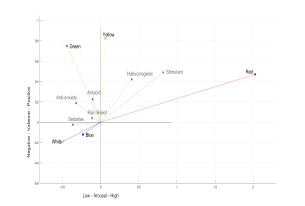
Colors, generally, have effects on human interpretations that can manifest in a variety of emotions, reactions, and behaviors. The objective of this study is to understand the reasoning behind the choices of pill colors in relation to expected efficacy of drugs, as well as the color associations made by participants. The research was conducted at several university campuses in USA, UAE, Croatia, Kosovo, and China, and focused on different age brackets, gender, ethnic backgrounds, educational levels, and pill usage frequency. Understanding the reasoning and color associations helps us better comprehend the expected efficacy of drugs, and can therefore support pharmaceutical companies in designing and manufacturing drugs, thereby maximizing the potential effect on patients’ adherence rates.
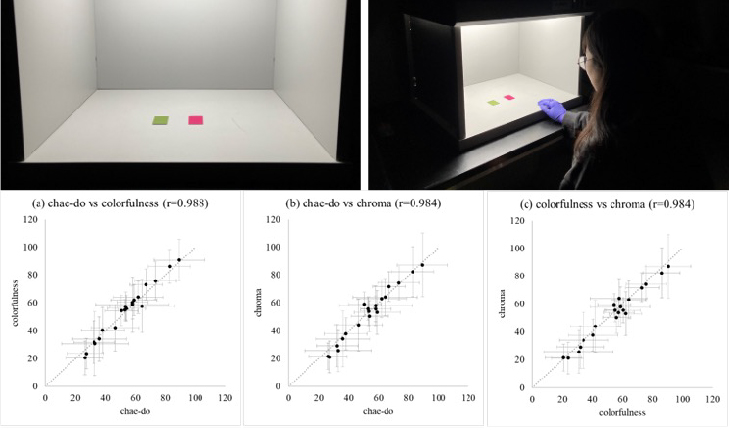
In this study, the relationships between chae-do, the commonly used Korean terminology to describe chromatic attributes, CIE definition for colorfulness, Munsell definition for chroma, Berns’ definition for CIELAB based vividness and depth are investigated. Although only the definitions were presented, without corresponding terminologies, the observers’ responses showed that chae-do is understood very similarly to the definitions of CIE colorfulness and Munsell chroma. Responses for the definitions of vividness and depth also showed high correlation with Berns’ CIELAB based vividness and depth predictions, which shows that definitions were well understood. No correlations were found between the definition of CIE colorfulness and the definition of vividness, which shows that the definition of vividness is understood differently to the definition of colorfulness. Comparing the response with color appearance model predictions, the responses showed good correlation with the predictions. Especially, colorfulness definition responses showed the highest coefficient correlation with CIELAB-based Berns’ depth prediction, implying the possibility of colorfulness predictor modification for better prediction. The findings can be further investigated to observers from other non-English speaking countries and collect meaningful cross-cultural color appearance data.

Last year at HVEI, I presented a computational model of lightness perception inspired by data from primate neurophysiology. That model first encodes local spatially-directed local contrast in the image, then integrates the resulting local contrast signals across space to compute lightness (Rudd, J Percept Imaging, 2020; HVEI Proceedings, 2021). Here I computer simulate the lightness model and generalize it to model color perception by including in the model local color contrast detectors that have properties similar to those of cortical “double-opponent” (DO) neurons. DO neurons make local spatial comparisons between the activities of L vs M and S vs (L + M) cones and half-wave rectify these local color contrast comparisons to produce psychophysical channels that encode, roughly, amounts of ‘red,’ ‘green’, ‘blue’, and ‘yellow.”

The human visual system is capable of adapting across a very wide dynamic range of luminance levels; values up to 14 log units have been reported. However, when the bright and dark areas of a scene are presented simultaneously to an observer, the bright stimulus produces significant glare in the visual system and prevents full adaptation to the dark areas, impairing the visual capability to discriminate details in the dark areas and limiting simultaneous dynamic range. Therefore, this simultaneous dynamic range will be much smaller, due to such impairment, than the successive dynamic range measurement across various levels of steady-state adaptation. Previous indirect derivations of simultaneous dynamic range have suggested between 2 and 3.5 log units. Most recently, Kunkel and Reinhard reported a value of 3.7 log units as an estimation of simultaneous dynamic range, but it was not measured directly. In this study, simultaneous dynamic range was measured directly through a psychophysical experiment. It was found that the simultaneous dynamic range is a bright-stimulus-luminance dependent value. A maximum simultaneous dynamic range was found to be approximately 3.3 log units. Based on the experimental data, a descriptive log-linear model and a nonlinear model were proposed to predict the simultaneous dynamic range as a function of stimulus size with bright-stimulus luminance-level dependent parameters. Furthermore, the effect of spatial frequency in the adapting pattern on the simultaneous dynamic range was explored. A log parabola function, representing a traditional Contrast Sensitivity Function (CSF), fitted the simultaneous dynamic range data well.

White balance is one of the key processes in a camera pipeline. Accuracy can be challenging when a scene is illuminated by multiple color light sources. We designed and built a studio which consisted of a controllable multiple LED light sources that produced a range of correlated color temperatures (CCTs) with high color fidelity that were used to illuminate test scenes. A two Alternative Forced Choice (2AFC) experiment was performed to evaluate the white balance appearance preference for images containing a model in the foreground and target objects in the background indoor scene. The foreground and background were lit by different combinations of cool to warm sources. The observers were asked to pick the one that was most aesthetically appealing to them. The results show that when the background is warm, the skin tones dominated observers' decisions and when the background is cool the preference shifts to scenes with same foreground and background CCT. The familiarity and unfamiliarity of objects in the background scene did not show a significant effect.

The appearance of color stimuli with luminance levels beyond the diffuse white is gaining importance due to the popularity of high dynamic range (HDR) displays. Past work on color appearance of stimuli, color appearance models, and uniform color spaces mainly focused on the stimuli with luminance levels below the diffuse white, which were produced using surface color samples or conventional standard dynamic range (SDR) displays. In this study, we focused on the perception of white appearance for stimuli with luminance beyond the diffuse white. Human observers adjusted the color appearance of a stimulus to the whitest under different adapting conditions, including a dark condition and 12 illuminated conditions. It was found that the chromaticities for producing the white appearance under the dark condition were generally similar to those under the 6500 K conditions, regardless of the adapting luminance levels. In comparison to a recent study focusing on the stimuli with luminance below the diffuse white, the perception of white under the conditions with the adapting CCT levels of 2700, 3500, and 5000 K was significantly affected by the lightness level of the stimulus, which cannot be accurately characterized by CAM02-UCS. The results can be used for reproducing white appearance for highlights in HDR scenes. Further investigations on uniform color spaces for characterizing stimuli with luminance beyond the diffuse white are urgently needed for processing and displaying HDR images.

In order to investigate the effect of ipRGC on color discrimination, it is necessary to reproduce two metameric light stimuli (we call these stimuli as metameric ipRGC stimuli) that have the same amount of cones and rods but different stimulus amount of ipRGC. However, it is difficult to independently control the amount of only ipRGC stimulation because the spectral sensitivity functions of the cones and rod overlap that of ipRGC in the wavelength band. So far, researchers have not addressed a comprehensive analysis of metameric ipRGC stimuli and color perception experiments for those stimuli. In this study, first, we proposed the calculation method of metameric ipRGC stimulus based on the orthogonal basis functions of human photoreceptors. Then, we clarified the controllable range of metameric ipRGC stimulus in the color gamut. Second, we conducted subjective evaluation experiments for investigating the discriminative colors due to metameric ipRGC stimuli. We showed the effects of ipRGC on color discrimination.